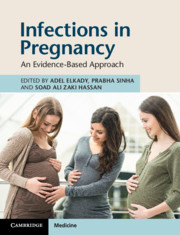Book contents
- Infections in Pregnancy
- Infections in Pregnancy
- Copyright page
- Contents
- Contributors
- Foreword
- Preface
- Section 1 Vaccination
- Section 2 Infections in Pregnancy
- Section 3 Postpartum Infections
- Chapter 29 Puerperal Sepsis
- Chapter 30 Puerperal Endometritis
- Chapter 31 Puerperal Mastitis
- Chapter 32 Breast Abscess
- Chapter 33 Pelvic Inflammatory Disease
- Index
- References
Chapter 31 - Puerperal Mastitis
from Section 3 - Postpartum Infections
Published online by Cambridge University Press: 11 October 2019
- Infections in Pregnancy
- Infections in Pregnancy
- Copyright page
- Contents
- Contributors
- Foreword
- Preface
- Section 1 Vaccination
- Section 2 Infections in Pregnancy
- Section 3 Postpartum Infections
- Chapter 29 Puerperal Sepsis
- Chapter 30 Puerperal Endometritis
- Chapter 31 Puerperal Mastitis
- Chapter 32 Breast Abscess
- Chapter 33 Pelvic Inflammatory Disease
- Index
- References
Summary
Mastitis is an infection in the tissue of one or both mammary glands inside the breasts.
It is rare during pregnancy, but more common during breastfeeding.
It is also known as lactation mastitis.
The incidence according to the World Health Organization (WHO) is between 5 and 33 per cent of breastfeeding mothers.
It usually presents during the first few weeks after delivery or at the time of weaning.
Between 10 and 33 per cent of breastfeeding women develop lactation mastitis. The incidence is highest in the first few weeks postpartum, decreasing gradually after that. However, cases may occur as long as the woman is breastfeeding.
In a retrospective study involving 136 459 deliveries in a US teaching hospital, the incidence of mastitis was 6.7 per 10 000 deliveries, and the incidence of mastitis with breast abscess was 2.6 per 10 000 deliveries. In the same study, the incidence of puerperal mastitis requiring hospital admission was seen most commonly with community-acquired MRSA (n = 18, 67%). [EL 2]
Severe cases are common in young primiparous women; just 23.7 per cent of the cases weaned their infants during the first six months after birth, due to mastitis.
The bacteria most commonly involved are Staphylococcus aureus (31 per cent) and Streptococci (10 per cent), through skin lesions of the nipple or through the opening of the nipple.
Staphylococcus infections tend to be more invasive and localised, leading to earlier abscess formation; while Streptococcus infections tend to present as diffuse mastitis with focal abscess formation in advanced stages. Gram-negative bacilli such as E. coli, Salmonella spp., mycobacteria, Candida and Cryptococcus have been identified in rare instances.
- Type
- Chapter
- Information
- Infections in PregnancyAn Evidence-Based Approach, pp. 183 - 185Publisher: Cambridge University PressPrint publication year: 2019

